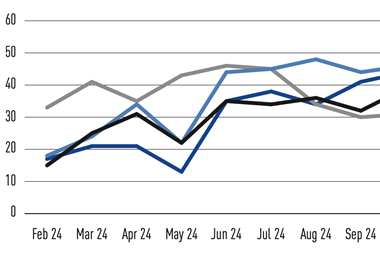The challenge facing the UK’s electricity industry a decade ago was that of converting its virtually monolithic industry-wide pension scheme into a system that met the needs of the new multi-employer environment.
In meeting this challenge the industry, both on the distribution and generating sides, has worked unceasingly since privatisation in the early 1990s to evolve a structure that is far from its industry-wide inheritance, of “one scheme, one pot of assets and one benefit structure throughout,” as Richard Barlow, chief executive of the Electricity Supply Pension Scheme, headquartered in London, describes it.
“A simple solution would have been to break up the scheme and to divide out the assets among the 17 new electricity companies being set up,” he says. But the members and their unions wanted to see if there was another solution that would provide greater continuity in protecting their pensions position. “Out of this discussion, a commitment was made that the ESPS would continue as a single-industry wide scheme and those employed in the industry at the time of privatisation, were ‘protected persons’ under the relevant electricity act,” points out Barlow. This status means that the employer either made the ESPS available to these employees or in the event of a wind up – which requires the consent of all the original employers – had to provide another scheme equivalent to it.
“Part of the mix was to go to a very clear two-tier basis. First, that each employer would have their own group within the scheme, and each of these groups would have their own body of group trustees.” From these group trustee bodies, two directors would be chosen, one appointed by the employers, the other from trustees elected by members to form a scheme-wide trustee body. “Each of the group of trustees at employer level is responsible for its own investment strategy, and each group is actuarially independent, and a separate valuation is done for each of them.” This means different surplus positions emerge and overtime the membership profile in different groups within the scheme can vary substantially, he points out. “There is quite a range of company size now in the industry.” Of the 26 groups covered in the £20bn (E32bn) scheme, the size varied from Innogy group with £2.7bn in assets to groups with assets under £1m.
On privatisation, in terms of the investment arrangements, the scheme’s fund was put on a unitised basis, and each of the groups had their actuarially determined number of units in the fund. “While that gave the correct asset value to each group, it did nothing to enable that group to adopt an investment structure suitable for its particular needs. So we introduced ‘sector unitisation’, by splitting the fund into a series of separate portfolios representing each of the major asset classes. In effect it was a series of in-house investment funds.”
These funds were priced weekly and each group could then switch units between one sector and another and move to its desired asset class exposure, he explains. “This was fine as far as it went, but there continued to be a single scheme manager, who managed 95% of the assets in-house. Within each asset class there could also only be one investment style and one performance objective”. It was agreed that something needed to be done on this point once the scheme had been given some time to establish itself.
“We called this process segregation, where each group would be able to appoint their own managers, in addition to being able to use the unitised funds and the managers appointed by the scheme-wide trustees.” These arrangements were introduced just four years ago. “We felt we needed to ensure that the in-house manager was not in some ‘pole-position’, so we split the company into two, one was an administration company (EPSL), but the fund management part would be sold.”
In the event, F&C Management Group purchased the operations. “This then gave us the ability to hire other fund managers, whether within the unitised funds or to manage segregated accounts for individual groups ,” says Barlow. As part of the deal, F&C was assured a continuing proportion of the business for a defined period of time but subject to meeting the strict requirements that the ESPS trustees set.
At that point no one knew to what extent the different groups would want to take up the option of other managers, but the framework was there for this to happen in an “orderly and economic fashion”, as he puts it. “We adopted certain mechanisms in which to do this. As the scheme-wide trustee was responsible for the process, they set ‘segregation opportunities’, where it was up to the group trustees to make use of these or not.” So at the opportunities, a group that wanted to select its own fund managers and determine their remit and remuneration of their manager could do so, but at the same time meet stringent scheme requirements. For example, they had to use the scheme-wide custodian, Bank of New York Europe, and continue to provide data to ESPS on a daily basis. “We use our standardised form for all manager agreements – not the managers’ own preferred form of agreement, but then the groups negotiate their own local terms by way of schedules to the agreement,” he points out. The scheme-wide trustee is responsible for the care, custody, control and accounting functions and applies a very robust control and accounting framework by using EPSL to maintain independent prime portfolio records, says Barlow. At the segregation opportunity, a ‘fair share’ of assets is transferred out of the unitised fund, and the new manager produces a wish list of the assets it requires. The transition process reorganises each portfolio from ‘fair share’ to ‘wish list’. “We do this for all of the groups’ managers and portfolios changing, and we press the button of our asset transfer model and it effects the transfers between one portfolio and another in a fair and efficient way. Clearly if everyone is moving in the same way, there is not much scope for swapping assets around, but the greater the extent to which people are moving in different directions, the greater the ability to transfer investments within the scheme.” The transitions included the biggest portfolio rebalancing that had ever taken place anywhere and were done without attracting media attention, at low cost and without adverse effect on fund value, which was the aim.
The main aim is to get groups as near as they can to their desired portfolios with the least amount of buying and selling in the market. “This has worked extraordinarily well, but only deals with part of the transition. To supplement that, the scheme-wide trustee has appointed Merrill Lynch Investment Managers’ transition team to complete the wish lists. This is to ensure that the sometimes sizeable transitions don’t have a knock-on effect on those holding the unitised assets.”
The scheme has organised seven of these opportunities over the past three years, usually every six months or so, and 90% of the scheme’s assets are now in the groups’ segregated funds, looked after by a range of 25 different managers, running 80 separate portfolios. F&C retains a major role in the scheme however, as it still manages most of the unitised funds and turned out to be the most successful manager in obtaining segregated portfolios.
Manager appointments within the unitised funds are made by the scheme-wide trustee. When ESPS decided to introduce segregation, it knew there was a risk that some of the unitised funds might no longer be sustainable and become too small, and in fact the scheme has wound up some of its specialist equity sector funds. “We needed to make sure that trustees who are happy within the unitised funds have other options open to them, such as balanced funds.” So having appointed F&C to manage one of these, the feeling was another option should be provided, this would then give choice. After going through a beauty parade and the normal selection procedures, a portfolio was given to Fidelity.
The scheme has a number of constraints built into its trust deed designed to ensure that no group can take any action which could have an adverse effect on other groups. This does put something of a damper on using some of “the more obscure investment options”, he says. “For example, we have a no gearing provision, which does limit activities. On the other hand, with the move to
segregation, many of the scheme’s investment procedures were freed up, so derivatives, which had been forbidden up then, were permitted.”
“But if the scheme does not lend itself to doing something, it does not mean it is ruled out forever,” Barlow notes. “For example, the scheme historically has not been able to engage in stock lending. Now we are looking at this provision to see if it can be removed, as we do not see why there should be a prohibition on this activity.” Hedge funds is where there seems to be more interest on the part of the product providers, but not so much on the part of the ESPS groups as yet.
In addition, Barlow considers that the scheme rules do not particularly fit in with private equity investment, particularly in the way that many of these investments are actually structured. “This is another option we are looking at currently. With the Myners’ review, we must look and see if there are any unnecessary constraints in our investment arrangements.
This scheme-wide and group structure has a number of strengths to it, he maintains. “While at the group level you are making your own decisions, you don’t have to look at issues 26 times. We have an investment strategy committee which looks at investment questions of scheme-wide interest: researching them, finding out about them, seeing if our rules can cater for them and then the group trustees decide if they want to do it.”
The two tier structure lets the groups do the sexy things they like to do regarding their pension arrangements, says Barlow. “It lets them decide about strategy, appoint fund managers, monitor performance, hopefully build a surplus and decide what to to do with it and get to decide the benefit structure. These are all things people like doing. But what they don’t like doing – the admin keeping of portfolio records, the ensuring of compliance, production of accounts – all these chores are carried out centrally by EPSL on behalf of the scheme-wide trustee.”
Since privatisation, the common benefit structure has diverged considerably as you would expect in a grouping of 26 different organisations. As the employers can decide how the surplus is used, they do this in consultation with the trustees, who inevitably have different views on how they would like it to be used. In fact, employers do not have to use the ESPS at all for those ‘non-protected persons’ who joined after privatisation and can have other schemes in place. One of the discussions now being undertaken within the scheme is about having defined contribution (DC) sections and Barlow believes that this should be possible sometime in the future. The additional flexibility DC brings could be attractive to employers and members, he believes.
The traditional contribution rate was 6% from the employee, plus 12% from the employer. “It is a set contribution rate scheme, with the employer liable to meet any shortfalls, while he has power to utilise the surplus. Currently, many group employers are enjoying contribution reductions. In fact, even with the market conditions of the last year, all of the groups’ arrangements remain in a strong, well-funded position, and well ahead of minimum funding requirement.”
The property exposure is just 3% of the fund but amounts to a sizeable portfolio of direct and indirect holdings, including a unitised UK property fund, managed by an F&C subsidiary.
He thinks the move to segregated assets at 90% has probably peaked and doesn’t expect there to be much change in this overall proportion in future.
“We have managed to provide this flexibility, but within a framework of a centralised arrangement, which provides some advantages that other schemes don’t have.” It gives market power and influence, and as an example, he points to the ESPS investment manager agreement, which is “our agreement not theirs!”
The scheme’s long and protracted court proceedings about the use of surplus ended earlier this year in the House of Lords. “The final outcome earlier this year, confirmed the employers’ responsibility for determining the use of surplus under the scheme’s trust deed.” That decision brought to an end what Barlow calls a “period of planning blight”, as people were waiting for the outcome of the court case.
“I think we have succeeded remarkably well in what we have set out to do.” But the road ahead is still one of introducing more flexibility. “I am very optimistic about the future of the scheme, despite all the bad press that pension provision generally and final salary schemes in particular seem to be getting these days.”












No comments yet